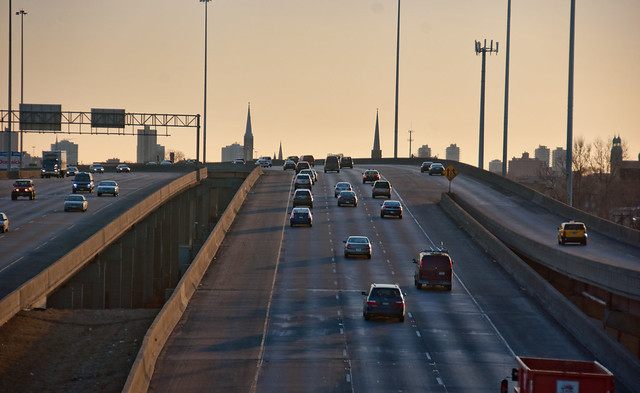
On Thursday, Governor Bruce Rauner announced a new proposal to address congestion on the Stevenson Expressway, aka I-55, by adding lanes. The construction would be financed via a public-private partnership, and the new lanes would be tolled. Revenue would go to the concessionaire, allowing them to recoup their investment.
The so-called “managed lanes” would be an option for drivers who are willing to pay a premium to bypass traffic, while the existing lanes would not be tolled. Some local transportation experts and advocates lauded the plan as a creative way to address congestion woes. But others argued that our region’s focus should be on providing better alternatives to single-occupant vehicle commutes, rather than simply building more capacity for them.
The proposed lanes would cover a 25-mile stretch of the Stevenson between the Dan Ryan Expressway and the Veteran’s Memorial Tollway, a segment that carries about 170,000 vehicles a day. The plan calls for adding at least one lane in each direction, at an estimated cost of $425 million. The P3 model would need to be approved by a majority of state lawmakers.
The new lanes would feature “congestion pricing” – the toll price would vary according to the number of cars in the managed lanes, as well as the rest of the expressway. Rauner said it’s possible that drivers with one or more passengers might be allowed to use the new lanes without paying a toll. The state hopes to finalize a design by this spring and start construction by late 2017.
The Metropolitan Planning Council pushed for several years in Springfield for legislation to enable this kind of public-private partnership, which passed in 2011. MPC executive vice president Peter Skosey said his organization applauds Rauner’s proposal, adding that adding capacity to I-55 is listed as a priority in the Chicago Metropolitan Agency for Planning’s GO TO 2040 regional plan.
“Experience shows that simply adding another regular lane will not ease congestion in the long term: once that capacity is there, it will just fill up,” Skosey said. “Putting a variable-priced toll on that lane lets you manage demand and keep it free-flowing. If you’re really in a time crunch, you have the choice to take that lane.”
Skosey argued that the new lane would also make taking the bus a more attractive choice. “[Pace’s] current Bus-on-Shoulder service has been incredibly successful, but it isn’t able to use the shoulder for the whole corridor and it’s limited to 35 mph. This lane would give it a continuous path and let it go as fast as 55 mph, improving reliability and opening the door to more frequent service.”
Steve Schlickmann, the former head of UIC’s Urban Transportation Center, agreed that the governor’s plan makes sense. “The combination of high congestion in regular travel lanes and insufficient growth in federal and state funding to maintain Illinois roads and transit, makes I-55 managed toll lanes a reasonable approach to address congestion and to help pay for I-55's on-going maintenance needs,” he said.
Fellow transportation expert Joe Schwieterman, director of DePaul’s Chaddick Institute for Metropolitan Development, also feels that the project has merits. “Both toll and HOV lanes encourage behavioral changes among motorists, which is good, but tolls have the advantage of generating positive cash flow,” he said. “Given the dire financial condition of our state, that is a huge plus.”
While Schwieterman implied that Rauner’s plan isn’t particularly progressive, he argued that it’s a step in the right direction. “Frankly, given that we have done so little to encourage more efficient highways use, besides simply raising tolls on the tollway system, most of us would welcome a project of this kind.”
But Scott Bernstein, president of the Center for Neighborhood Technology, said the Governor’s proposal seems to put too much focus on moving cars, rather than people. “It’s being justified in terms of congestion,” he said. “I didn’t hear anything about demand reduction. In a true managed corridor, you’d have bus lanes and HOV lanes, things that don’t assume single-occupant vehicles are going to be the primary mode.”
He argued that some of the revenue from the tolled lanes should be used to fund additional transit service. “And if you wanted to talk about creating bus-only lanes, that would be real leadership.”
Active Transportation Alliance director Ron Burke said his organization would support converting existing travel lanes on the Stevenson to managed lanes. “However, adding more lanes for cars -- be they conventional, car pool or tolled lanes -- only exacerbates traffic congestion in the long run while making non-auto options less viable,” he said.
Burke argued that new highway capacity in urban areas like Chicagoland leads to more driving, more congestion, and car-centric development patterns that often discourage walking, biking, and transit use. Moreover, he added, there would be traffic impacts due to more cars going to and from the Stevenson on roads that have not been widened.
“Investments in car-dependent travel and the land use patterns that follow further alienate and strand people who cannot afford cars or are unable to drive, as well as those who choose not to drive,” Burke said. “To reduce congestion and enhance mobility, the state and the region should focus on reducing driving demand rather than accommodating it through supply-side strategies like adding lanes.”
Burke argued that a better approach for the Stevenson would be to maintain the existing lane configuration and reduce traffic demand by converting existing lanes to HOV lanes, adding bus-only lanes, improving Metra and other transit options, and deploying transportation demand management strategies that help people meet their transportation needs while driving less.
![]()
Did you appreciate this post? Streetsblog Chicago is currently funded until April 2016. Consider making a donation through our PublicGood site to help ensure we can continue to publish next year.





